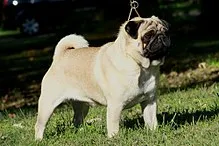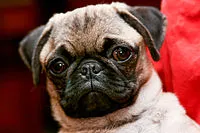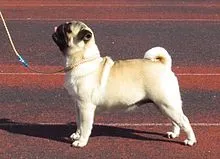 The Pug is a breed of dog with physically distinctive features of a wrinkly, short-muzzled face, and curled tail. The breed has a fine, glossy coat that comes in a variety of colours, most often fawn or black, and a compact square body with well-developed muscles.
The Pug is a breed of dog with physically distinctive features of a wrinkly, short-muzzled face, and curled tail. The breed has a fine, glossy coat that comes in a variety of colours, most often fawn or black, and a compact square body with well-developed muscles.
Pugs were brought from China to Europe in the sixteenth century and were popularized in Western Europe by the House of Orange of the Netherlands, and the House of Stuart.[2] In the United Kingdom, in the nineteenth century, Queen Victoria developed a passion for pugs which she passed on to other members of the Royal family.
Pugs are known for being sociable and gentle companion dogs.[3] The American Kennel Club describes the breed's personality as "even-tempered and charming".[4] Pugs remain popular into the twenty-first century, with some famous celebrity owners. A pug was judged Best in Show at the World Dog Show in 2004.

Physical characteristics
While the pugs that are depicted in eighteenth century prints tend to be long and lean,[2] modern breed preferences are for a square cobby body, a compact form, a deep chest, and well-developed muscle.[4] Their smooth and glossy coats can be fawn, apricot fawn, silver fawn, or black.[4][6] The markings are clearly defined, and there is a trace of a black line extending from the occiput to the tail.[4] The tail normally curls tightly over the hip.[2]
Pugs have two distinct shapes for their ears, "rose" and "button". "Rose" ears are smaller than the standard style of "button" ears, and are folded with the front edge against the side of the head. Breeding preference goes to "button" style ears.[7]
Pugs' legs are very strong, straight, of moderate length, and are set well under. Their shoulders are moderately laid back. Their ankles are strong, their feet are small, their toes are well split-up, and their nails are black.[4] The lower teeth normally protrude further than their upper, resulting in an under-bite.[1]
Temperament
The breed is often described by the Latin phrase multum in parvo, or "much in little" or "a lot of dog in a small space", alluding to the Pug's remarkable and charming personality, despite its small size.[1] Pugs are strong willed but rarely aggressive, and are suitable for families with children. The majority of the breed is very fond of children and sturdy enough to properly play with them. Depending on their owner's mood, they can be quiet and docile but also vivacious and teasing.[8] Pugs tend to be intuitive and sensitive to the moods of their owners and are usually eager to please them.[3] Pugs tend to have a somewhat lazy nature and spend a lot of time napping. They are often called "shadows" because they follow their owners around and like to stay close to the action,[9] craving attention and affection from their owners